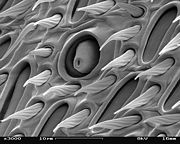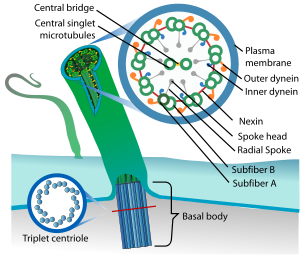
Antenna (biology)
Encyclopedia

Appendage
In invertebrate biology, an appendage is an external body part, or natural prolongation, that protrudes from an organism's body . It is a general term that covers any of the homologous body parts that may extend from a body segment...
s used for sensing
Sensory system
A sensory system is a part of the nervous system responsible for processing sensory information. A sensory system consists of sensory receptors, neural pathways, and parts of the brain involved in sensory perception. Commonly recognized sensory systems are those for vision, hearing, somatic...
in arthropod
Arthropod
An arthropod is an invertebrate animal having an exoskeleton , a segmented body, and jointed appendages. Arthropods are members of the phylum Arthropoda , and include the insects, arachnids, crustaceans, and others...
s. More recently, the term has also been applied to cilium
Cilium
A cilium is an organelle found in eukaryotic cells. Cilia are slender protuberances that project from the much larger cell body....
structures present in most cell
Cell (biology)
The cell is the basic structural and functional unit of all known living organisms. It is the smallest unit of life that is classified as a living thing, and is often called the building block of life. The Alberts text discusses how the "cellular building blocks" move to shape developing embryos....
types of eukaryote
Eukaryote
A eukaryote is an organism whose cells contain complex structures enclosed within membranes. Eukaryotes may more formally be referred to as the taxon Eukarya or Eukaryota. The defining membrane-bound structure that sets eukaryotic cells apart from prokaryotic cells is the nucleus, or nuclear...
s.
In arthropod
Arthropod
An arthropod is an invertebrate animal having an exoskeleton , a segmented body, and jointed appendages. Arthropods are members of the phylum Arthropoda , and include the insects, arachnids, crustaceans, and others...
s, antennae are connected to the front-most segments
Morphogenesis
Morphogenesis , is the biological process that causes an organism to develop its shape...
. In crustacean
Crustacean
Crustaceans form a very large group of arthropods, usually treated as a subphylum, which includes such familiar animals as crabs, lobsters, crayfish, shrimp, krill and barnacles. The 50,000 described species range in size from Stygotantulus stocki at , to the Japanese spider crab with a leg span...
s, they are biramous and present on the first two segments of the head, with the smaller pair known as antennules. All other arthropod groups - except chelicerates
Chelicerata
The subphylum Chelicerata constitutes one of the major subdivisions of the phylum Arthropoda, and includes horseshoe crabs, scorpions, spiders and mites...
and proturans, which have none - have a single, uniramous pair of antennae. These antennae are jointed, at least at the base, and, in general, extend forward from the head. They are sensory organ
Sensory system
A sensory system is a part of the nervous system responsible for processing sensory information. A sensory system consists of sensory receptors, neural pathways, and parts of the brain involved in sensory perception. Commonly recognized sensory systems are those for vision, hearing, somatic...
s, although the exact nature of what they sense and how they sense it is not the same in all groups, or always clear. Functions may variously include sensing touch, air motion, heat, vibration (sound), and especially olfaction
Olfaction
Olfaction is the sense of smell. This sense is mediated by specialized sensory cells of the nasal cavity of vertebrates, and, by analogy, sensory cells of the antennae of invertebrates...
(smell) or gustation (taste).
Insects


Olfaction
Olfaction is the sense of smell. This sense is mediated by specialized sensory cells of the nasal cavity of vertebrates, and, by analogy, sensory cells of the antennae of invertebrates...
sensors of insects and are accordingly well-equipped with a wide variety of sensilla (singular: sensillum). Paired, mobile, and segmented, they are located between the eyes on the forehead. Embryologically, they represent the appendages of the second head segment.
All insects have antenna, however they may be greatly reduced in the larval forms. Amongst the non-insect classes of Hexapoda
Hexapoda
The subphylum Hexapoda constitutes the largest grouping of arthropods and includes the insects as well as three much smaller groups of wingless arthropods: Collembola, Protura, and Diplura . The Collembola are very abundant in terrestrial environments...
, Collembola and Diplura have antenna, but Protura do not.
Structure
The three basic segments of the typical insect antenna are the scape (base), the pedicel (stem), and finally the flagellum, which often comprises many units known as flagellomeres.The number of flagellomeres can vary greatly, and is often of diagnostic importance. True flagellomeres have a membranous articulation between them, but, in many insects, especially the more primitive groups, the flagellum is entirely or partially composed of a flexible series of small annuli, which are not true flagellomeres.
In many beetle
Beetle
Coleoptera is an order of insects commonly called beetles. The word "coleoptera" is from the Greek , koleos, "sheath"; and , pteron, "wing", thus "sheathed wing". Coleoptera contains more species than any other order, constituting almost 25% of all known life-forms...
s and in the chalcidoid wasps, the apical flagellomeres form a club, and the collective term for the segments between the club and the antennal base is the funicle; for traditional reasons, in beetles it is the segments between the club and the scape, but, in wasps, it is the segments between the club and the pedicel.
In the groups with more uniform antennae (for example: Diplopoda), all segments are called antennomeres. Some groups have a simple or variously modified apical or subapical bristle called an arista
Arista (biology)
In insect anatomy the arista is a simple or variously modified apical or subapical bristle, arising from the third antennal segment. It is the evolutionary remains of antennal segments, and may sometimes show signs of segmentation...
(this may be especially well-developed in various Diptera
Diptera
Diptera , or true flies, is the order of insects possessing only a single pair of wings on the mesothorax; the metathorax bears a pair of drumstick like structures called the halteres, the remnants of the hind wings. It is a large order, containing an estimated 240,000 species, although under half...
).
Functions
Olfactory receptorOlfactory receptor
Olfactory receptors expressed in the cell membranes of olfactory receptor neurons are responsible for the detection of odor molecules. Activated olfactory receptors are the initial player in a signal transduction cascade which ultimately produces a nerve impulse which is transmitted to the brain...
s on the antennae bind to free-floating molecules, such as water vapour, and odour
Odor
An odor or odour is caused by one or more volatilized chemical compounds, generally at a very low concentration, that humans or other animals perceive by the sense of olfaction. Odors are also commonly called scents, which can refer to both pleasant and unpleasant odors...
s including pheromone
Pheromone
A pheromone is a secreted or excreted chemical factor that triggers a social response in members of the same species. Pheromones are chemicals capable of acting outside the body of the secreting individual to impact the behavior of the receiving individual...
s. The neuron
Neuron
A neuron is an electrically excitable cell that processes and transmits information by electrical and chemical signaling. Chemical signaling occurs via synapses, specialized connections with other cells. Neurons connect to each other to form networks. Neurons are the core components of the nervous...
s that possess these receptors signal this binding by sending action potential
Action potential
In physiology, an action potential is a short-lasting event in which the electrical membrane potential of a cell rapidly rises and falls, following a consistent trajectory. Action potentials occur in several types of animal cells, called excitable cells, which include neurons, muscle cells, and...
s down their axon
Axon
An axon is a long, slender projection of a nerve cell, or neuron, that conducts electrical impulses away from the neuron's cell body or soma....
s to the antennal lobe
Antennal lobe
The antennal lobe is the deutocerebral neuropil of insect which receives the input from the olfactory sensory neurons on the antenna. Functionally, it shares some similarities with the olfactory bulb in vertebrates....
in the brain
Brain
The brain is the center of the nervous system in all vertebrate and most invertebrate animals—only a few primitive invertebrates such as sponges, jellyfish, sea squirts and starfishes do not have one. It is located in the head, usually close to primary sensory apparatus such as vision, hearing,...
. From there, neurons in the antennal lobes connect to mushroom bodies
Mushroom bodies
The mushroom bodies or corpora pedunculata are a pair of structures in the brain of insects and other arthropods.-Structure:Mushroom bodies are usually described as neuropils, i.e. as dense networks of neuronal processes and glia...
that identify the odour. The sum of the electrical potentials of the antenna to a given odour can be measured using an electroantennogram.
In the case of the Monarch butterfly, it has been shown that antennae are necessary for proper time-compensated solar compass
Solar compass
The solar compass, an astronomical instrument, was first invented and made by William Austin Burt. He patented it on February 25, 1836, in the United States Patent Office as No 9428X. It received a medal at the Great Exhibition of 1851...
orientation during migration, that antennal clocks exist in monarchs, and that they are likely to provide the primary timing mechanism for Sun compass orientation.
Crustaceans
CrustaceanCrustacean
Crustaceans form a very large group of arthropods, usually treated as a subphylum, which includes such familiar animals as crabs, lobsters, crayfish, shrimp, krill and barnacles. The 50,000 described species range in size from Stygotantulus stocki at , to the Japanese spider crab with a leg span...
s bear two pairs of antennae. The first pair are uniramous and are often referred to as antennules, while the second pair are biramous, meaning that each antenna is composed of two parts, joined at their base . In most adults, the antenna are sensory organs, but they are used by the nauplius larva
Larva
A larva is a distinct juvenile form many animals undergo before metamorphosis into adults. Animals with indirect development such as insects, amphibians, or cnidarians typically have a larval phase of their life cycle...
for swimming. In some groups of crustaceans, such as the spiny lobster
Spiny lobster
Spiny lobsters, also known as langouste or rock lobsters, are a family of about 45 species of achelate crustaceans, in the Decapoda Reptantia...
s and slipper lobster
Slipper lobster
Slipper lobsters are a family of decapod crustaceans found in all warm oceans and seas. Despite their name, they are not true lobsters, but are more closely related to spiny lobsters and furry lobsters. Slipper lobsters are instantly recognisable by their enlarged antennae, which project forward...
s, the second antennae are enlarged, while, in others, such as crab
Crab
True crabs are decapod crustaceans of the infraorder Brachyura, which typically have a very short projecting "tail" , or where the reduced abdomen is entirely hidden under the thorax...
s, the antennae are reduced in size.
Cellular antennae

Biology
Biology is a natural science concerned with the study of life and living organisms, including their structure, function, growth, origin, evolution, distribution, and taxonomy. Biology is a vast subject containing many subdivisions, topics, and disciplines...
and medical
Medicine
Medicine is the science and art of healing. It encompasses a variety of health care practices evolved to maintain and restore health by the prevention and treatment of illness....
disciplines, recent discoveries have noted that primary cilia in many types of cells
Cell (biology)
The cell is the basic structural and functional unit of all known living organisms. It is the smallest unit of life that is classified as a living thing, and is often called the building block of life. The Alberts text discusses how the "cellular building blocks" move to shape developing embryos....
within eukaryotes serve as cellular antennae. These cilia play important roles in chemosensation
Chemosensor
A chemoreceptor, also known as chemosensor, is a sensory receptor that transduces a chemical signal into an action potential. In more general terms, a chemosensor detects certain chemical stimuli in the environment.- Classes :...
, mechanosensation
Mechanosensation
Mechanosensation is a response mechanism to mechanical stimuli. The physiological foundation for the senses of touch, hearing and balance, and pain is the conversion of mechanical stimuli into neuronal signals: mechanosensation. Mechanoreceptors of the skin, called cutaneous mechanoreceptors, are...
, and thermosensation. The current scientific understanding of primary cilia organelles views them as "sensory cellular antennae that coordinate a large number of cellular signaling pathways, sometimes coupling the signaling to ciliary motility or alternatively to cell division and differentiation."
"Almost every vertebrate
Vertebrate
Vertebrates are animals that are members of the subphylum Vertebrata . Vertebrates are the largest group of chordates, with currently about 58,000 species described. Vertebrates include the jawless fishes, bony fishes, sharks and rays, amphibians, reptiles, mammals, and birds...
cell has a specialized cell surface projection called a primary cilium. …primary cilia are key participants in intercellular signaling. This new appreciation of primary cilia as cellular antennae that sense a wide variety of signals could help explain why ciliary defects
Ciliopathy
A ciliopathy is a genetic disorder of the cellular cilia or the cilia anchoring structures, the basal bodies, or of ciliary function.Although ciliopathies are usually considered to involve proteins that localize to the primary cilia or centrosomes, it is possible for ciliopathies to be associated...
underlie such a wide range of human disorders, including retinal degeneration
Retinopathy
Retinopathy is a general term that refers to some form of non-inflammatory damage to the retina of the eye. Frequently, retinopathy is an ocular manifestation of systemic disease.-Pathophysiology:Causes of retinopathy are varied:...
, polycystic kidney disease
Polycystic kidney disease
Autosomal dominant polycystic kidney disease is an inherited systemic disorder that predominantly affects the kidneys, but may affect other organs including the liver, pancreas, brain, and arterial blood vessels...
, Bardet-Biedl syndrome
Bardet-Biedl syndrome
The Bardet–Biedl syndrome is a ciliopathic human genetic disorder that produces many effects and affects many body systems. It is characterized principally by obesity, retinitis pigmentosa, polydactyly, mental retardation, hypogonadism, and renal failure in some cases.-Summary of the...
, and neural tube defects."

